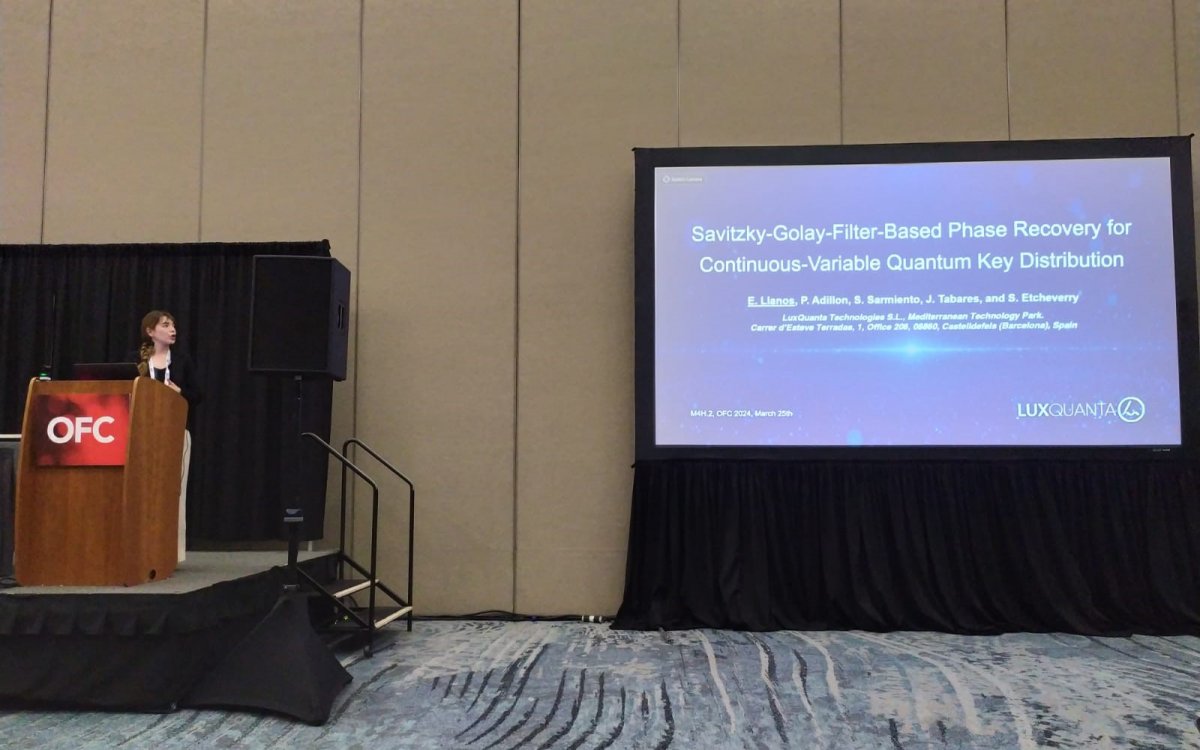Research Paper Explained: Savitzky-Golay Filter-Based Phase Recovery for CV-QKD
Llanos, E.; Adillon, P., Sarmiento-Hernández, S.; Tabares, J. and Etcheverry, S. Savitzky-Golay Filter-Based Phase Recovery for CV-QKD. OFC Conference 2024.
March 2024 - Elisabeth Llanos presented LuxQuanta's research paper "Savitzky-Golay Filter-Based Phase Recovery for CV-QKD" at the OFC Conference as the first author. The study was conducted under the supervision of LuxQuanta's lead Optical Design engineer, Dr. Samael Sarmiento, with the collaboration of Pol Adillon, PhD Student.
The present technical blog aims to explain the study and its preliminary results in an easier-to-understand way for technical readers who are not experts in the subject. You will learn about one of the key parameters to optimize in CV-QKD and the effect of the different filters used to extend the reachable link distance in CV-QKD. Would it be possible to reach 100 km?
Let's dive in.
Quantum Key Distribution
Quantum Key Distribution (QKD) is a complex, multi-layered technology that harnesses the fundamentals of quantum mechanics to generate and distribute symmetric cryptographic keys between two parties without using mathematical algorithms. The keys generated are future-safe and resistant to all types of computational attacks, even those of future Quantum Computers.The technology, first proposed in 1984 and tested during the ’90s, has been commercially available since the early 2000s. However, it's important to note that today, we can find two main variants* of the technology: the original one, Discrete Variable QKD (DV-QKD), and a more recent and innovative one, Continuous Variable QKD (CV-QKD).
Unlike DV-QKD, Continuous Variable QKD (CV-QKD) encodes the information in the X- and P-quadratures of the electromagnetic field of light, removing the need for single-photon detectors, which need to be operated at very demanding temperature conditions. Instead, CV-QKD employs coherent detectors that can be implemented with off-the-shelf telecom components.
Despite being a newer variant, CV-QKD has already made its mark in the market and is being implemented in real-world scenarios globally by various providers, including LuxQuanta. This demonstrates its commercial viability and evidence of its potential for further improvement and optimization. The focus is primarily on extending the maximum distance covered and enhancing overall performance, painting a promising picture for the future of CV-QKD technology.
Among the different parameters to work on, Phase Noise is one of the critical parameters to optimize. Its reduction is not just a technical challenge, but by reducing the amount of Phase Noise, we can enable the technology to cover greater distances, ultimately increasing the amount of real-use cases where CV-QKD technology could be deployed.
.png) About the authors. Elisabeth Llanos, first author and PhD student at LuxQuanta under Dr. Samael Sarmiento supervision. Dr. Sarmiento works as Lead Optical Design Engineer at LuxQuanta, leading the R&D efforts on photonic integration. Pol Adillon, second author and PhD student as well, works along Elisabeth in the Dr. Sarmiento's department.
About the authors. Elisabeth Llanos, first author and PhD student at LuxQuanta under Dr. Samael Sarmiento supervision. Dr. Sarmiento works as Lead Optical Design Engineer at LuxQuanta, leading the R&D efforts on photonic integration. Pol Adillon, second author and PhD student as well, works along Elisabeth in the Dr. Sarmiento's department. Phase Noise
Phase noise refers to random signal phase or waveform fluctuations, typically caused by oscillator imperfections, thermal noise, or environmental conditions. In the context of CV-QKD, the phase noise of the quantum symbols during the transmission and reception of the signal degrades the overall performance of the link by introducing errors and limiting overall achievable communication distances.
In the CV-QKD receiver system, the coherent detector requires a local oscillator (LO) laser to retrieve the signal containing the quantum information. To simplify and increase the security of practical CV-QKD systems, the LO must be independent of what is used in the transmitter and generated locally on the receiver’s side.
Therefore, one of the main goals of CV-QKD manufacturers is to increase the signal-to-noise ratio (SNR), thus increasing the secret key rate (SKR) and the overall achievable distance between two endpoints.
Enhancing Phase Noise Correction
The main objective of the present paper, led by Dr Sarmiento as lead researcher and mainly carried out by LuxQuanta’s PhD students Elisabeth Llanos and Pol Adillon as first authors, is to enhance the correction of phase noise by using a filtering technique not used before in CV-QKD scenario.
Several techniques are available to reduce the amount of phase noise introduced in a system, pilot-aided phase recovery techniques being one of the most widely used. In this technique, the phase error of the quantum signal is estimated from the phase of a classical reference signal (pilot), usually multiplexed in time or frequency with the quantum signal.
However, although proven effective, a strong reference signal close to the quantum one brings a remaining phase error that needs to be reduced. A set of mathematical algorithms known as Kalman filters has been proposed recently to solve this problem. These algorithms adjust the readings based on estimations by considering the model's predictions and actual measurements, mitigating the crosstalk from the pilot tone to the quantum signal while keeping the pilot tone power high enough to maximise its SNR at the detection.
In this paper, Llanos et al. employ the Savitzky-Golay (SG) Kalman digital filtering technique to improve phase recovery and compare it with implementing the Unscented Kalman Filter (UKF), the most novel state-of-the-art technique in phase recovery. The main goal is to evaluate SG filters, never used before in CV-QKD, and assess their efficacy in increasing SNR, SKR and ultimately, the maximum distance of the link.
Savitzky-Golay (SG) & Unscented Kalman Filter (UKF)
Understanding the main differences between the two filters assessed in the paper is essential. Let's dive into them without entering a too complex and technical analysis of both filters.
As described above, both filters reduce the phase noise by either smoothing the signal or making an extremely accurate prediction. We will now see how Llanos et al. evaluated the efficacy of SG compared with the UKF filter.
How the Filters were Assessed
The experiment used a regular experimental setup of two CV-QKD systems, a transmitter and a receiver. For simplicity purposes, the methodology description assumes a basic understanding of the usual setup of CV-QKD technology not extend to the detailed technical explanation of each component observed in Fig. 1.
To test the efficacy of the filters above, the authors needed to set up a CV-QKD link, retrieve the received quantum data, and, after pilot-aided recovery (see before), test the SG filter in comparison with UKF. The following steps were taken.
First, a signal from a laser beam at the transmitter was generated by modulating it. Quantum pulses, multiplexed in frequency with a pilot (reference) tone, were sent to the transmitter through a 10.9 km optical fiber link. Frequency multiplexing implies that the quantum signal is transmitted simultaneously with the pilot tone but in different frequencies, allowing a precise phase noise estimation from the reference tone.
Quantum information, retrieved at the receiver with a local oscillator to amplify it and be used to generate the cryptographic secret key, is encoded in the quantum pulses by modulating the phase and amplitude parameters of the quantum signals. A heterodyne detector is placed in the receiver to retrieve this encoded information, which can detect X and P quadratures of light and read the quantum-encoded information.
Then, at the receiver, the received signal has to be demultiplexed, separating the quantum pulses and the pilot tones that were multiplexed in frequency at the transmitter. From the pilot tone, the phase noise of the quantum pulse was estimated through pilot-aided phase recovery techniques.
However, as described before, the resulting phase noise estimation is still noisy, mainly due to additional noise caused by many unconsidered factors. To solve this, the Kalman filters enter the scene.
The present study now applies the SG or UKF filters to smooth the noisy phase noise measurements. The aim is to obtain a more accurate phase noise estimation and correct the quantum symbols received accordingly.
Lastly, the correlation between Alice’s emitted signal and Bob's received data was assessed, and the secret key rate (SKR) amount was measured. The SKR is directly related to the correlation between data. The more SKR, the better the filter performs at smoothing the noise and the longer distances the system can reach.
Experimental Results
When comparing the excess noise and the SKR obtained when using SG or UKF filter, preliminary results show that SG outperforms the state-of-the-art UKF filter in CV-QKD scenarios. Let’s dive deeper into the results.
When using SG filters, the average SKR improvement is 29.2% when using SGF, while in UKF, it is 12.5%. In other words, compared to the UKF, the SGF shows an average SKR improvement of 15%.These results can be observed in detail in Fig. 2 a and b, where the SKR and excess noise for 28 consecutive measurements are shown in three scenarios: no filter applied, with UKF and SG..png)
Overall, we can observe lower noise when using SG and increased SKR.
Finally, the results were extrapolated to compute and simulate the effective link distance for secure communications based on obtained SKR and excess noise. Fig. 2(c) depicts a simulation of SKR as a function of the transmission distance or how long a QKD link can perform depending on the SKR obtained. The results show that positive SKR values could be obtained up to 48 km and 41 km for the SGF and UKF, respectively. When no phase estimation filters are used, the distance limit is 36 km.
Therefore, using the SG filter increases the maximum achievable link distance by 7 km more than the state-of-the-art UKF filter and 12 km more when no filter is applied.
Conclusions & Important Considerations: CV-QKD reaching 100 Km?
In addition to the above results and the overall better performance of SG filters, the authors also argue that, based on the study results, a more profound system optimisation would allow the link to reach even longer fibre distances of up to 100km or more.
These results, however, depend heavily on the lasers' linewidth. In Llanos et al.'s experimental setup, the linewidth is 10KHz, a relatively wide and realistic one generally used for commercial systems. However, it is essential to note that in other experiments with narrower linewidth lasers, which are more research-oriented and less suited for integration in commercial applications, a UKF filter may work better or show similar performances than an SG one.
This difference is mainly due to the filter's intrinsic properties. In the latter case (experimental setup, narrower linewidth), the UKF filter that implements the predictive model considered in this work, could better correct the phase noise because the filter prediction better matches the noise process.
Therefore, although the current study shows promising results in optimising the CV-QKD system's maximum distance reach using SG filters, it is essential to understand the system characteristics we are working on within each case to use the proper techniques and obtain the best possible performance.
What is clear is that further experiments should be placed to stretch the practical limits of CV-QKD performance in commercial applications, which is what ultimately will secure the world's most critical data from the threat of quantum computing.
Adapted from the original research paper: Llanos, E.; Adillon, P., Sarmiento-Hernández, S.; Tabares, J. and Etcheverry, S. Savitzky-Golay Filter-Based Phase Recovery for CV-QKD. OFC Conference 2024.
Entry written by Sergi Vizcaíno.
Contact us to know more at info@luxquanta.com

